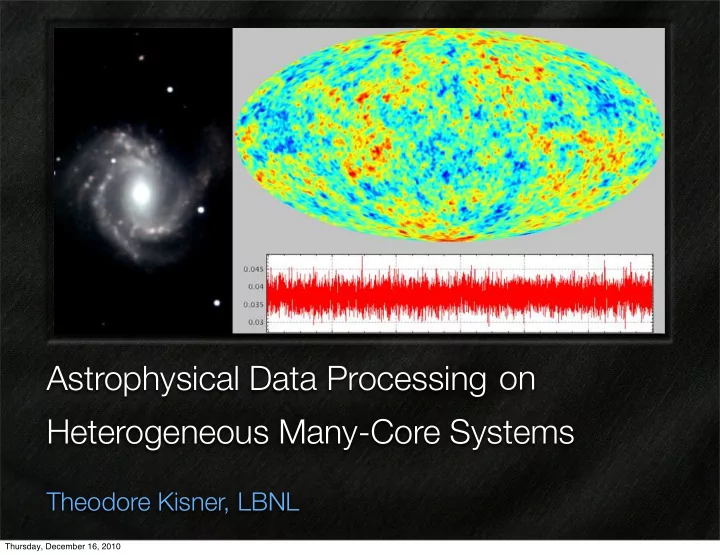

on Astrophysical Data Processing Heterogeneous Many-Core Systems Theodore Kisner, LBNL Thursday, December 16, 2010
Astrophysical Data Processing Data Acquisition Data Manipulation / Calculations Data Indexing / Storage Data Selection / Retrieval Data Manipulation / Calculations High Level Results T. Kisner, LBNL - HiPACC 12/16/2010 Thursday, December 16, 2010
Astrophysical Data Processing Data Acquisition Data Manipulation / Calculations Data Indexing / Storage Data Selection / Retrieval Data Manipulation / Calculations High Level Results T. Kisner, LBNL - HiPACC 12/16/2010 Thursday, December 16, 2010
Astrophysical Data Processing Data Manipulation / Calculations Image Operations: linear combination, filtering (2D FFT), sampling Timestream Operations: linear combination, filtering (1D FFT) Spherical Geometry: projection, pixelization, spherical harmonic transforms Monte Carlo Error Estimation: parallel random number generation T. Kisner, LBNL - HiPACC 12/16/2010 Thursday, December 16, 2010
Why Many-Core Systems? (See Kathy’s Talk) Electrical power is a finite resource - must increase “Flops / Watt” Traditional CPUs: optimize serial performance, increase clock speed, instruction-level parallelism, hardware cache management. The New Reality: use more transistors for calculation, pack them into many simpler cores, clock speeds ~1GHz or less, cache partially managed by software driver / application. T. Kisner, LBNL - HiPACC 12/16/2010 Thursday, December 16, 2010
Many-Core Systems Today Most systems are heterogeneous- some traditional CPU cores for running OS, serial bottlenecks, coordination of lightweight cores, etc Practical performance is constrained by data movement across multi-level memory hierarchy Examples- multi-core CPU, plus one or more cards: T. Kisner, LBNL - HiPACC 12/16/2010 Thursday, December 16, 2010
Goal : Scale Relevant Calculations Would like a cross-platform library of tools that “just works” for the operations important to astrophysical data processing Compilers are not magical, and there are no existing “mid-level” libraries that are cross-platform... What tools do exist? Name Notes Open Source? NVIDIA CuFFT, CuBLAS Cuda Only; subset of needed tools NO PGI Accelerator Cuda Only; OpenMP style syntax NO AccelerEyes LibJacket Cuda Only; Wide range of tools! NO BrownDeer LibStdCL OpenCL helper tools GPLv3 GPU Systems Libra Cuda/OpenCL; range of math ops NO Intel MKL Intel only; math ops NO T. Kisner, LBNL - HiPACC 12/16/2010 Thursday, December 16, 2010
One Path Forward - Middle Layer Tools Use OpenCL for cross-platform support Build a collection of Kernels for common data processing operations Do simple tuning based on detected hardware properties + simple parameter space search Provide a high-level interface to access these tools Work has already begun... T. Kisner, LBNL - HiPACC 12/16/2010 Thursday, December 16, 2010
Example: Pixelization of Detector Pointing Traditionally done with the HEALPix software library Instead, implement as an OpenCL Kernel: contains one conditional, cos, sqrt, etc T. Kisner, LBNL - HiPACC 12/16/2010 Thursday, December 16, 2010
Example: Pixelization of Detector Pointing Timing Comparison of OpenCL HEALPix Angle to Pixel Kernel Serial OpenMP OpenCL - CPU Same Kernel !! OpenCL - GPU 0 3.75 7.50 11.25 15.00 Seconds OS X, Core i7 Quad, ATI Radeon 4850 Linux, Athlon X4 Quad, NVIDIA GTX 285 Linux, 2 x Intel Xeon Quad, NVIDIA Tesla 2050 (Fermi) T. Kisner, LBNL - HiPACC 12/16/2010 Thursday, December 16, 2010
Conclusions OpenCL is a promising foundation for astrophysical calculations on heterogeneous many-core systems For real-world use, we need high-level tools Constructing a portable library of compute kernels for astrophysics seems both a tractable and useful path into the many-core future Much work to be done! T. Kisner, LBNL - HiPACC 12/16/2010 Thursday, December 16, 2010
Recommend
More recommend